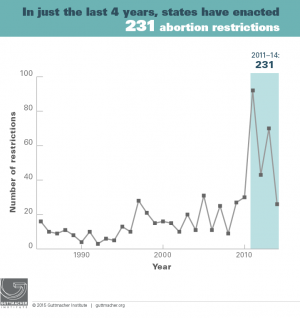On Thursday, the 42nd anniversary of the Supreme Court's landmark Roe vs. Wade decision to legalize abortion nationwide, House Republicans had intended to vote on a proposal banning abortions at the 20-week post-conception period. But rather than approving the so-called “fetal pain” measure, the House swapped it for a watered down bill that would weaken insurance coverage for the procedure. It was a last minute switch was made after a small group of mostly female Republican lawmakers came out strongly opposing the more restrictive measure.
All of which begs the question: what are current abortion laws?
Easier asked than answered.
Although Roe v. Wade, the 1973 landmark Supreme Court decision, established a woman's constitutional right to an abortion, it did little to prevent individual states from enacting their own laws tightening restrictions on the procedure. So while all 50 states must permit some form of abortion, per the court's ruling, many conservative states have enacted restrictions to making the procedure far more difficult.
 In recent years, anti-abortion campaigns have increasingly geared their efforts towards passing restrictive abortion laws in individual states, rather than at the federal level. In 2013 alone, state legislatures enacted 70 laws restricting abortion access, ranging from bans on abortions at 20 weeks post-conception to limitations on insurance coverage for the procedure, according to the Guttmacher Institute, a pro-choice advocacy group that tracks state laws. In fact, more abortions restrictions were enacted from 2011 to 2013 than in the entire previous decade.
In recent years, anti-abortion campaigns have increasingly geared their efforts towards passing restrictive abortion laws in individual states, rather than at the federal level. In 2013 alone, state legislatures enacted 70 laws restricting abortion access, ranging from bans on abortions at 20 weeks post-conception to limitations on insurance coverage for the procedure, according to the Guttmacher Institute, a pro-choice advocacy group that tracks state laws. In fact, more abortions restrictions were enacted from 2011 to 2013 than in the entire previous decade.
